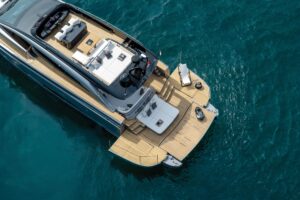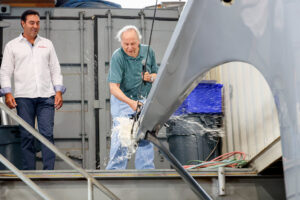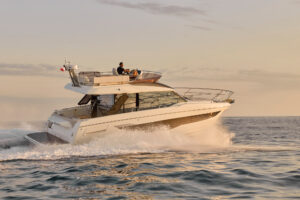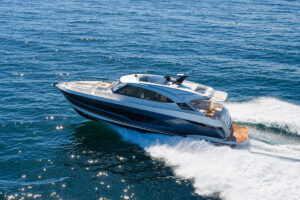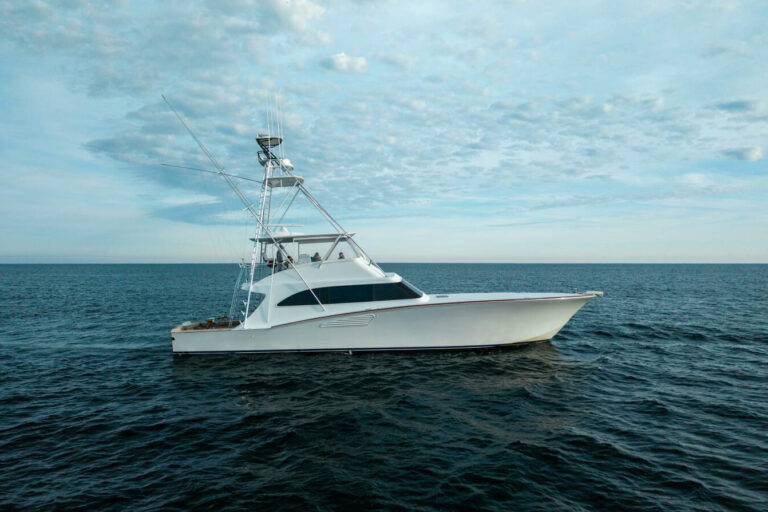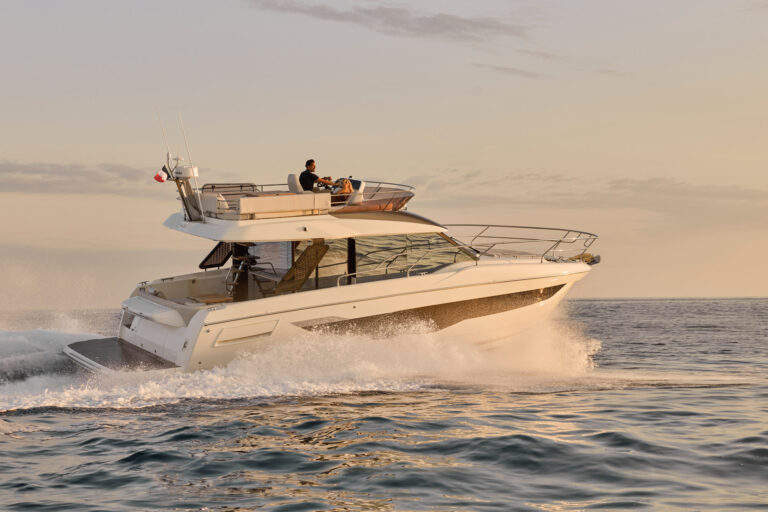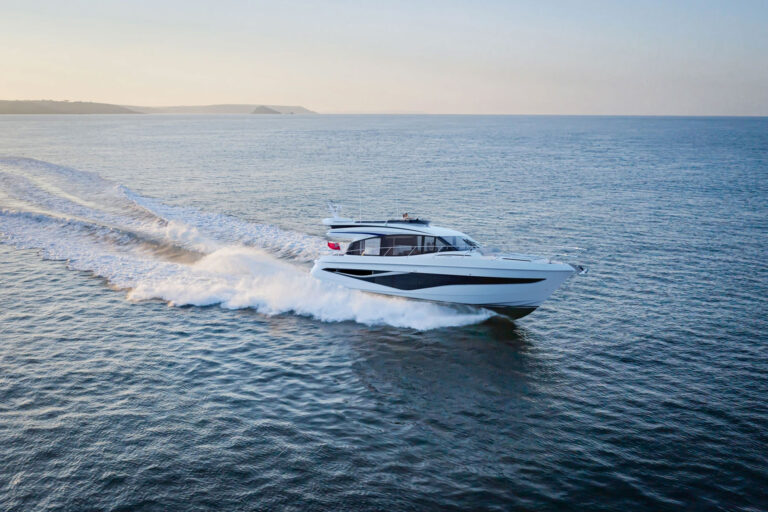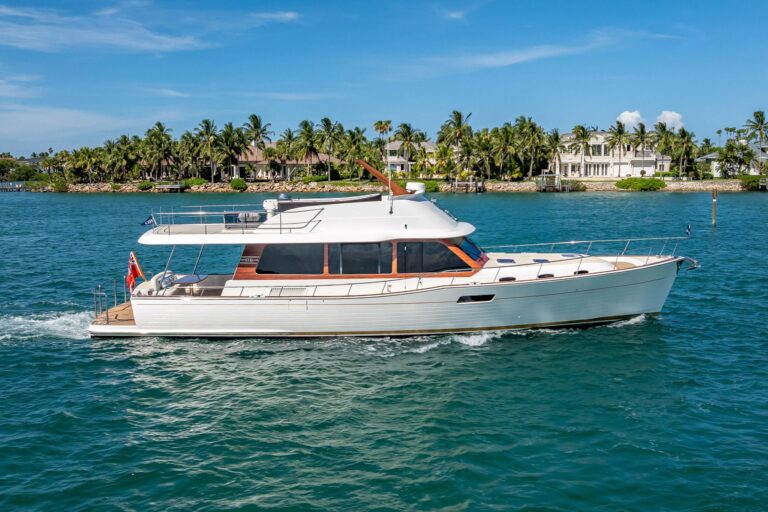There are a lot of decent boats built in Taiwan these days, but the 70 Marlow Explorer is different. She has the very special feel of a boat built without compromise.
“In the early days of the trawler boom, the Taiwanese were inspired by example and simply copied practices and techniques imported from other countries, said David Marlow, who spends 22 weeks a year at the yard. “Today, a more confident generation of Taiwanese craftsmen are far more inventive.
That attitude, combined with Marlow’s personal history, tells you a lot about this yacht. Marlow is the son of a commercial fisherman, was building boats before he could shave and went to sea before he could drive. After six years of service aboard commercial ships, he made landfall. Through hard work and a bit of luck, he earned a solid reputation and success in yacht sales. He spared no expense in creating the 70, yet not a cent was invested in her thoughtlessly. Her outfitting and finish are exceptional, yet her price is a bargain in her class.
“In the past, the focus was on doing things faster, Marlow said. “I challenge our craftsmen to do things better.
The 70 is, in many ways, a showcase of details. All cabinet interiors, even the cutouts for built-in appliances, are finished. Drawers have dovetailed wood interiors and hearty metal slides. End grain on the exterior teak rails is capped, and joints are scarfed. With the exception of the German interior hardware, all of the 70’s stainless steel is custom fabricated in Taiwan by a company that specializes in aviation-grade weldments. The work is spectacular.
Marlow has the cost advantage of selling the 70 factory-direct, but there is more to the story. Whether bypassing middlemen and buying teak by the log or bargaining for container space to ship U.S.-made components to the yard, Marlow is tenacious in his quest to trim the fat.
“I learned the value of money early on because I didn’t have any, he said.
His facility is designed specifically for and dedicated to the 70’s production. Developing tooling and training craftsmen in the use of modern materials required a significant investment. Stitched multi-directional reinforcements are used exclusively, and the 70’s bottom and topsides are cored with foam, which is vacuum-bagged in place. Two layers of Kevlar reinforcement beneath the gelcoat provide additional puncture resistance. Bulkheads are cored fiberglass, and stringers are molded fiberglass over foam. Foam coring is also used in non-structural bulkheads and to stiffen interior and exterior decks.
In all, Marlow’s approach is high-tech for a market where more traditional fiberglass construction methods are the norm. Carefully designed and detailed systems complement the 70’s clean, finished bilges.
While yacht designer Doug Zurn assisted, Marlow penned the profile and arrangement. Her silhouette has a salty, traditional flavor, yet is too contemporary to be branded a trawler yacht. This is in large part because of her reverse transom, the feature that sets her apart from her smaller sister.
Dark colors do not favor poorly tooled fiberglass, and the 70’s rich blue gelcoat is as fair and blemish-free as any I have seen. Teak decking is bonded in place, and dimpled nonslip surfaces are effective, yet easy on the flesh. Tempered, laminated safety glass, custom made in England, is bonded into molded-in receivers in the superstructure tooling and should be leak-free.
Marlow has a number of stock interior and exterior layouts for the 70, however, he is handy with the pen and seems to take pleasure in dealing with challenging clients. To date, no two boats have been quite the same.
I tested hull number six of the 65-70 series, which was created for an East Coast yachtsman moving up from a 55-footer. The 70’s covered afterdeck has built-in seating, a wet bar, a barbecue and controls hidden in the molded-in cabinetwork. There is also bench seating on the bow. Stairs lead to the boat deck/flying bridge, and there is direct access to the exterior helm station from the pilothouse. The flying bridge helm is not segregated and is central to a lounge area with a wet bar, a refrigerator and a barbecue. This is a feature owner-operators will appreciate.
The detail and craftsmanship in the 70’s satin-finished teak interior is well above average and some of the finest work I have seen from Taiwan’s gifted joiners. Access is from the afterdeck, or from pilothouse doors to port and starboard. The deckhouse’s open arrangement enhances the sense of interior volume. The saloon is aft, the galley is amidships and the pilothouse/lounge is forward. This is a conventional approach, however, Marlow cleverly arranged things so that it is possible to eyeball the stern from the pilothouse-an advantage for shorthanded operation.
A stair in the saloon leads to a split-level master stateroom with a king berth. There are separate head and shower compartments, and an office area is a step down. Two guest staterooms with private heads are accessible from a stair in the pilothouse. Stairs aft in the saloon lead to a crew/kids’ cabin, and to engineroom access. Exterior access to the engineroom is possible by sacrificing the afterdeck wet bar and barbecue.
Marlow spent many hours fussing with hull forms, and the result is rather unique. While the 70’s foundation is a conventional semi-displacement form, she has twin strut keels that surround the propeller shafts in hydrodynamic fairings. Marlow’s own data, gleaned from comparing the 65 with and without the fairings, suggest the strut keels improve efficiency and tracking. They also offer partial protection of the wheels, and modest propeller pockets keep draft to just 4 feet, 5 inches.
It took no more than five minutes for Marlow and me to crank up the 70’s pair of 800 hp Caterpillar 3406Es and cast off. With full side decks, plenty of power and a two-speed bow thruster, an experienced couple would have no problem handling her. I would suggest either wing stations or a plug-in remote on her Portuguese bridge.
Our sea trial was conducted all up with full fuel, full water, a tender and about 14,000 pounds of owner’s gear aboard. I recorded a top speed of 23.2 knots at 2300 rpm and a cruising speed of 20.5 knots at 2100 rpm. Marlow’s data indicate that she gains a few knots lightly loaded. Easing along at 2000 rpm, I recorded a speed of 17.9 knots and the Caterpillar electronics indicated a fuel burn of 54 gallons per hour.
If the 70 were just an average boat, her $1,500,000 base price would be a good deal. She is much more. She is proof that it’s not simply money that makes a great boat.
Contact: Marlow Explorer Yachts, (941) 729-3370; sales@marlowmarine.com; www.marlowmarine.com.

